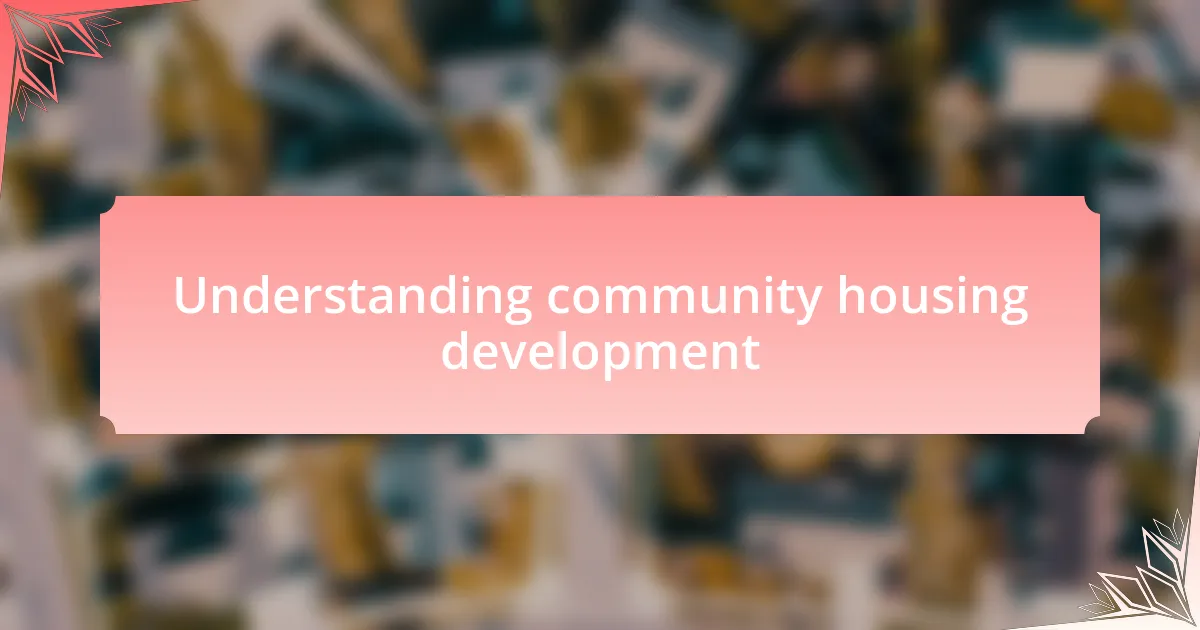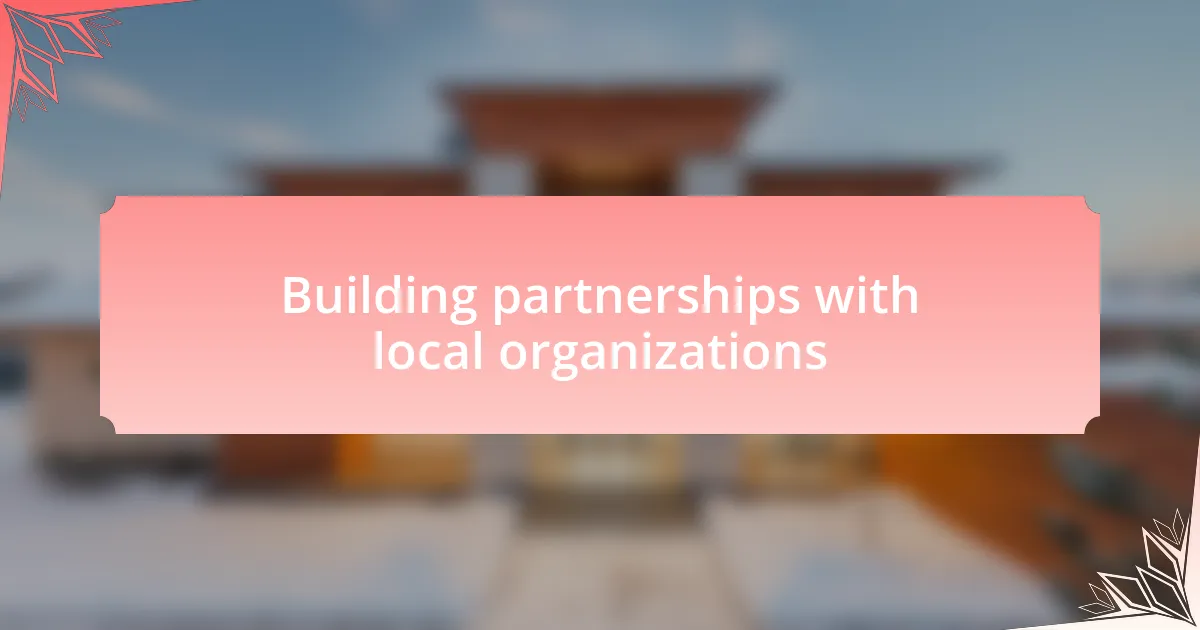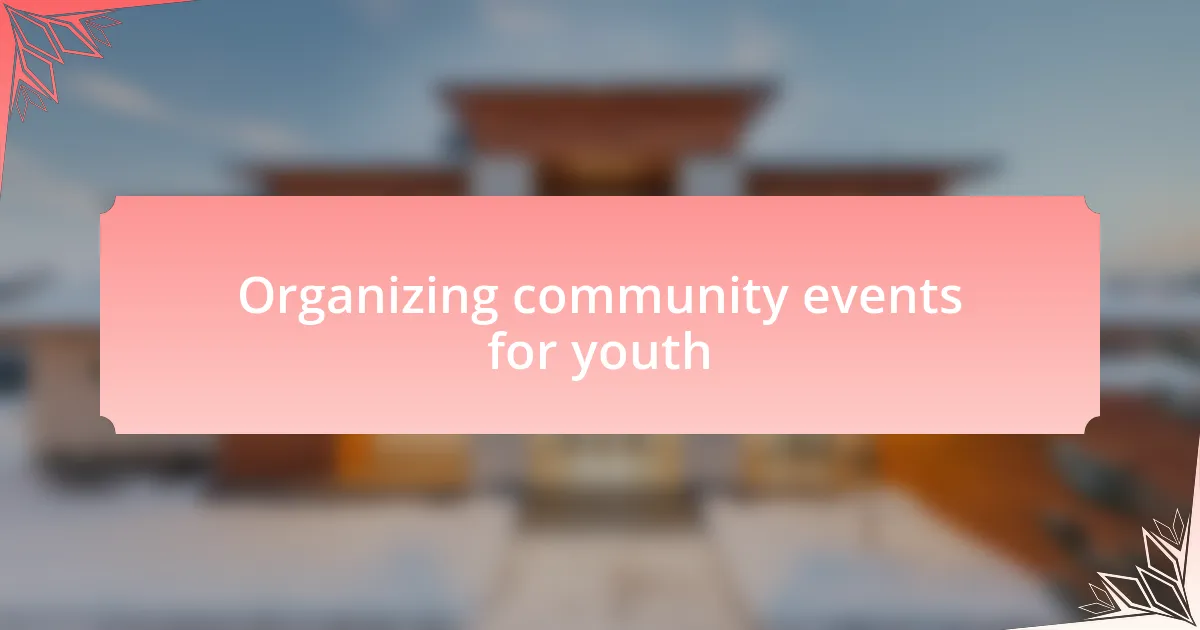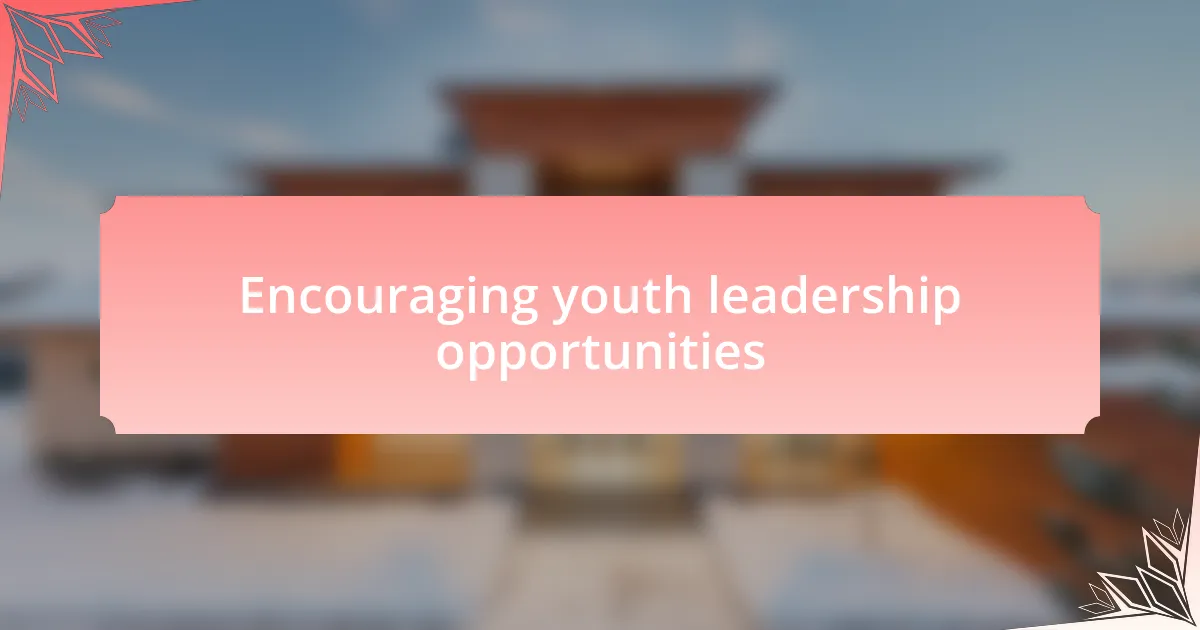Key takeaways:
- Community housing development enhances sense of belonging and stability, fostering connections among residents.
- Engaging youth in community initiatives brings fresh perspectives and cultivates a sense of ownership that leads to long-term success.
- Building partnerships with local organizations amplifies resources and creates a vibrant network of support for youth engagement.
- Measuring the impact of youth involvement through qualitative and quantitative methods reveals significant personal and community benefits.

Understanding community housing development
Community housing development is a vital process that aims to create affordable and sustainable living options for individuals and families. I remember when I first learned about the impact of such initiatives in my own neighborhood. It struck me how transformative a well-planned housing project could be for a community struggling with high living costs.
Think about this: what makes a home more than just four walls? For many, it’s about feeling a sense of belonging and stability. In my experience, community housing development not only provides shelter but also fosters connections among residents, creating vibrant neighborhoods where people support one another. I’ve seen firsthand how these developments can turn isolated individuals into friends and collaborators.
The journey of community housing development involves engaging various stakeholders, from local governments to non-profits and residents themselves. I’ve witnessed community meetings where emotions ran high as people expressed their hopes and concerns. This engagement is crucial, as it ensures that the projects truly reflect the needs of those who will live in them, bridging gaps and inspiring collective ownership of the space.

Importance of youth engagement
Engaging youth in community initiatives is essential because they bring fresh perspectives and innovative ideas. I remember during a local forum where a group of young people proposed a community garden to address food insecurity. Their enthusiasm and creativity were infectious, prompting even older residents to jump on board. It made me realize how vital it is to give youth a platform; they often see solutions that adults might overlook.
Moreover, youth involvement fosters a sense of ownership that is crucial for the vitality of any project. In one project I worked on, we tasked high school students with planning summer events in a community park. Seeing their pride in organizing everything—from selecting activities to designing marketing materials—was inspiring. It was clear that when young people feel invested, they actively contribute to the long-term success of community spaces.
Finally, including youth in discussions about housing and community planning ensures the needs of future generations are represented. I’ve often pondered how decisions made today can impact tomorrow’s citizens. When I reflect on my own childhood and the spaces I grew up in, I see how important it is for young people to voice their opinions, shaping a community that feels welcoming and safe for everyone, now and in the future.

Strategies for engaging youth
One effective strategy for engaging youth is to create mentorship programs that connect them with local leaders. I recall a time when we matched aspiring young entrepreneurs with seasoned business owners in our area. The transformation was remarkable; the youth gained invaluable insights, while the mentors found their passion reignited by the fresh energy of their mentees. How often do we overlook the power of personal connection? Those mentorship relationships not only foster growth but also build a supportive network that enriches the entire community.
Another approach is to incorporate technology and social media into youth engagement initiatives. In my experience, we launched an online platform where young people could discuss local issues and propose solutions. It was fascinating to see them share ideas and collaborate, harnessing the same tools they use daily. I often wonder how many great solutions go unrecognized simply because we aren’t meeting youth where they are. By using platforms they already engage with, we can spark conversations that lead to real change.
Lastly, hosting dynamic events that cater specifically to youth interests can significantly boost their involvement. I remember organizing a local music festival aimed at bringing younger residents together. It served not just as entertainment but as a backdrop for community dialogue about local issues. The excitement was palpable, and many attendees shared their thoughts on housing and community needs in a way that felt natural and enjoyable. Isn’t it interesting how vibrant experiences can lead to meaningful conversations? Engaging youth through activities they love can cultivate a deeper connection to the community and its future.

Building partnerships with local organizations
Building partnerships with local organizations has been a game changer for our youth engagement efforts. I remember a collaborative project with a local art collective that allowed young artists to showcase their work in community spaces. The enthusiasm of the artists and the positive feedback from visitors created an inspiring environment where youth felt valued and heard. Have you ever seen the impact of art on a community? It truly can elevate voices that might otherwise go unnoticed.
In my experience, these partnerships don’t just connect resources; they create a vibrant network of support and innovation. For instance, we collaborated with a nearby youth center to develop workshops on financial literacy. The partnership allowed us to tap into their expertise while providing a space for young people to learn vital life skills. It’s incredible how sharing resources can amplify our reach and make our efforts more effective. Imagine the potential when organizations come together for a common purpose.
I’ve also seen firsthand how local businesses benefit from these collaborations. By joining forces with a local café, we hosted open mic nights where youth could express themselves through poetry and music. Not only did this give young talents a platform, but the café saw an increase in foot traffic and community engagement. You might ask, what do we gain from these partnerships? The answer is simple: a strengthened sense of community and a shared commitment to the growth and success of our youth.

Organizing community events for youth
Organizing community events for youth has been a cornerstone of fostering engagement and connection. One of my most memorable experiences was coordinating a summer sports festival that featured various activities, from soccer to skateboarding. Watching young people rally together, cheering each other on, created an electric atmosphere filled with energy and camaraderie. Have you ever been part of something that allowed you to discover new talents and forge friendships in the process? It was truly uplifting to see their enthusiasm.
I also remember hosting a series of community movie nights in the park. We set up a big screen and invited everyone to bring blankets and snacks. What surprised me the most was the way it became a gathering point for families and youth alike. Sharing stories under the stars not only sparked conversations but also helped strengthen connections within our community. Isn’t it fascinating how a simple film can evoke such powerful emotions and discussions?
The feedback from these events often revealed deeper insights into the needs and interests of our youth. For instance, after a hackathon we organized, participants expressed a desire for more tech-related workshops. This feedback led us to create ongoing coding classes, which have subsequently drawn in more students eager to learn. Isn’t it amazing how listening can lead to further opportunities and better outcomes? Each event ignited a spark of creativity, showcasing the potential that lies within our youth when we create nurturing spaces for them to thrive.

Encouraging youth leadership opportunities
Empowering youth with leadership opportunities can significantly change their perspectives and aspirations. I once facilitated a youth leadership workshop where participants were encouraged to share their ideas for community improvement projects. The room buzzed with excitement as they brainstormed innovative solutions, and I could see palpable confidence blossom in those who were once shy. Have you noticed how a little encouragement can unleash creativity?
In another instance, I partnered with local organizations to create a mentorship program that paired high school students with community leaders. Watching these young individuals engage in meaningful conversations and develop actionable plans was awe-inspiring. It reassured me that when given the right tools and support, youth can lead not only themselves but also inspire others. Isn’t it fascinating to witness the ripple effect of nurturing potential?
Additionally, promoting youth-led initiatives, such as starting a community garden, can cultivate essential life skills. I vividly recall how a group of teens came together to plan, plant, and maintain the garden. Their pride in seeing their efforts flourish was heartwarming and transformative. How often do we overlook the untapped potential in our youth when we don’t allow them to take the reins? It’s a reminder that real leadership is about creating spaces where young voices are not only heard but celebrated.

Measuring impact of youth involvement
Measuring the impact of youth involvement requires a combination of qualitative and quantitative approaches. I remember organizing a community event where youth were tasked with gathering feedback from attendees. The insights they collected not only highlighted the event’s successes but also pointed to areas needing improvement—something I hadn’t expected them to grasp so quickly. Isn’t it empowering to see young people actively shaping the direction of community projects?
In another project, we used surveys to assess the skills gained by participants in a summer program I ran. The results revealed significant boosts in confidence and teamwork, which were surprising yet gratifying. This kind of data is essential; it tells a story about the tangible effects youth engagement can have—not just on the individuals themselves but on the community as a whole.
Tracking participation rates over time also offers invaluable insights. After implementing a youth leadership program, I noted a steady increase in volunteerism among the participants. It’s fascinating how those initial experiences can spark a lifelong commitment to community service. How often do we underestimate the long-term benefits of youth involvement when we focus on short-term outcomes?